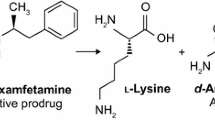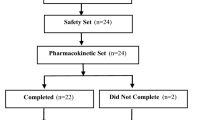Abstract
Rationale
Adderall® is currently used for the treatment of Attention-Deficit Hyperactivity Disorder (ADHD) and is composed of a novel mixture of approximately 24% l-amphetamine and 76% d-amphetamine salts. There are, however, no investigations of the pharmacological effects of this combination in vivo.
Objectives
The technique of high-speed chronoamperometry using Nafion®-coated single carbon-fiber microelectrodes was used to study amphetamine-evoked dopamine (DA) release produced by Adderall®, d-amphetamine, or d,l-amphetamine in the striatum of anesthetized male Fischer 344 (F344) rats. The amphetamine solutions were locally applied from micropipettes by pressure ejection.
Results
Local applications of Adderall® resulted in significantly greater DA release signal amplitudes with prolonged time course of dopamine release and re-uptake as compared to d-amphetamine and d,l-amphetamine.
Conclusions
These data support the hypothesis that the combination of amphetamine enantiomers and salts in Adderall® has effects on DA release, which result in increased and prolonged DA release, compared to d- and d,l-amphetamine.




Similar content being viewed by others
References
Arnold LE, McCloske K, Snyder SH, Wender PH (1972) Levoamphetamine and dextroamphetamine-comparative efficacy in hyperkinetic syndrome-assessment by target symptoms. Arch Gen Psychiatry 27:816–822
Arnold LE, Heusits RD, Smelzer DJ, Scheib J, Wemmer D, Colner G (1976) Levoamphetamine vs dextroamphetamine in minimal brain dysfunction. Arch Gen Psychiatry 33:292–301
Biederman J, Faraone SV (2002) Current concepts on the neurobiology of attention-deficit/hyperactivity disorder. J Atten Disord 6(Suppl 1):S7–S16
Carboni E, Imperato A, Perezzani L, Dichiara G (1989) Amphetamine, cocaine, phencyclidine and nomifensine increase extracellular dopamine concentrations preferentially in the nucleus accumbens of freely moving rats. Neuroscience 28:653–661
Cass WA, Gerhardt GA (1995) In vivo assessment of dopamine uptake in rat medial prefrontal cortex: comparison with dorsal striatum and nucleus accumbens. J Neurochem 65:201–207
Cass WA, Gehardt GA, Mayfield RD, Curella P, Zahniser NR (1992) Differences in dopamine clearance and diffusion in rat striatum and nucleus accumbens following systemic cocaine administration. J Neurochem 59:259–266
Cass WA, Gerhardt GA, Gillespie K, Curella P, Mayfield RD, Zahniser NR (1993a) Reduced clearance of exogenous dopamine in rat nucleus-accumbens, but not in dorsal striatum, following cocaine challenge in rats withdrawn from repeated cocaine administration. J Neurochem 61:273–283
Cass WA, Zahniser NR, Flach KA, Gerhardt GA (1993b) Clearance of exogenous dopamine in rat dorsal striatum and nucleus accumbens—role of metabolism and effects of locally applied uptake inhibitors. J Neurochem 61:2269–2278
Cody JT, Valtier S, Nelson SL (2003) Amphetamine enantiomer excretion profile following administration of Adderall. J Anal Toxicol 27:485–492
Cooper JR, Bloom FE, Roth RH (1996) The biochemical basis of neuropharmacology: 7th edn. Oxford University Press, New York
Elia J, Borcherding BG, Rapoport JL, Keysor CS (1991) Methylphenidate and dextroamphetamine treatments of hyperactivity: are there true nonresponders? Psychiatry Res 36:141–155
Friedemann MN, Gerhardt GA (1992) Regional effects of aging on dopaminergic function in the Fischer 344 rat. Neurobiol Aging 13:325–332
Gerhardt GA, Palmer MR (1987) Characterization of the techniques of pressure ejection and microionotophoresis using in vivo electrochemistry. J Neurosci Methods 22:147–159
Gerhardt GA, Hoffman AF (2001) Effects of recording media composition on the responses of nafion-coated carbon fiber microelectrodes measured using high-speed chronoamperometry. J Neurosci Methods 109:13–21
Gerhardt GA, Rose GM, Hoffer BJ (1986) Release of monoamines from striatum of rat and mouse evoked by local application of potassium—evaluation of a new in vivo electrochemical technique. J Neurochem 46:842–850
Gerhardt GA, Rose GM, Hoffer BJ (1987) In vivo electrochemical demonstration of potassium-evoked monoamine release from rat cerebellum. Brain Res 413:327–335
Giros B, Jones SR, Wightman RM, Caron MG (1996) Hyperlocomotion and indifference to cocaine and amphetamine in mice lacking the dopamine transporter. Nature 379:606–612
Glaser PEA, Thomas TC, Joyce BM, Castellanos FX, Gerhardt GA (2005) Differential effects of amphetamine isomers on dopamine release in the rat striatum and nucleus accumbens core. Psychopharmacology (Berl) 178:250–258
Glowinski J, Axelrod J, Iverson LL (1966) Regional studies of catecholamines in rat brain. IV. Effects of drugs on disposition and metabolism of H3-norepinephrine and H3-dopamine. J Pharmacol Exp Ther 153:30–41
Gnegy ME, Khoshbouei H, Berg KA, Javitch JA, Clarke WP, Zhang M, Galli A (2004) Intracellular Ca2+ regulates amphetamine-induced dopamine efflux and currents mediated by the human dopamine transporter. Mol Pharmacol 66:137–143
Goodman M, Nachman G (2000) The ADHD market: it’s time to pay attention. Morgan Stanley Dean Witter, New York
Goodman LS, Gilman A, Hardman JG, Limbird LE, Gilman AG (2001) Goodman and Gilman’s the pharmacological basis of therapeutics, 10th edn. McGraw-Hill, New York
Gulley JM, Zahniser NR (2003) Rapid regulation of dopamine transporter function by substrates, blockers and presynaptic receptor ligands. Eur J Pharmacol 479:139–152
Gulley JM, Doolen S, Zahniser NR (2002) Brief, repeated exposure to substrates down-regulates dopamine transporter function in xenopus oocytes in vitro and rat dorsal striatum in vivo. J Neurochem 83:400–411
Hebert MA, Gerhardt GA (1999) Age-related changes in the capacity, rate, and modulation of dopamine uptake within the striatum and nucleus accumbens of Fischer 344 rats: an in vivo electrochemical study. J Pharmacol Exp Ther 288:879–887
Hoffman AF, Gerhardt GA (1999) Differences in pharmacological properties of dopamine release between the substantia nigra and striatum: an in vivo electrochemical study. J Pharmacol Exp Ther 289:455–463
Hurlbert SH (1984) Pseudoreplication and the design of ecological field experiments. Ecol Monogr 54:187–211
James RS, Sharp WS, Bastain TM, Lee PP, Walter JM, Czarnolewski M, Castellanos FX (2001) Double-blind, placebo-controlled study of single-dose amphetamine formulations in ADHD. J Am Acad Child Adolesc Psych 40:1268–1276
Johnson LA, Furman CA, Zhang M, Guptaroy B, Gnegy ME (2005) Rapid delivery of the dopamine transporter to the plasmalemmal membrane upon amphetamine stimulation. Neuropharmacology 49:750–758
Kahlig KM, Galli A (2003) Regulation of dopamine transporter function and plasma membrane expression by dopamine, amphetamine, and cocaine. Eur J Pharmacol 479:153–158
Kahlig KM, Javitch JA, Galli A (2004) Amphetamine regulation of dopamine transport-combined measurements of transporter currents and transporter imaging support the endocytosis of an active carrier. J Biol Chem 279:8966–8975
Kahlig KM, Binda F, Khoshbouei H, Blakely RD, McMahon DG, Javitch JA, Galli A (2005) Amphetamine induces dopamine efflux through a dopamine transporter channel. Proc Natl Acad Sci U S A 102:3495–3500
Kametani H, Iijima S, Spangler EL, Ingram DK, Joseph JA (1995) In vivo assessment of striatal dopamine release in the aged male Fischer 344 rat. Neurobiol Aging 16(4):639–646
Khoshbouei H, Sen N, Guptaroy B, Johnson L, Lund D, Gnegy M, Galli A, Javitch JA (2004) N-terminal phosphorylation of the dopamine transporter is required for amphetamine-induced efflux. PLoS Biol 2(3):0387–0393
Kuczenski R, Segal DS (2001) Locomotor effects of acute and repeated threshold doses of amphetamine and methylphenidate: relative roles of dopamine and norepinephrine. J Pharmacol Exp Ther 296:876–883
Luthman J, Friedemann MN, Hoffer BJ, Gerhardt GA (1993) In vivo electrochemical measurements of exogenous dopamine clearance in normal and neonatal 6-hydroxydopamine-treated rat striatum. Exp Neurol 122:273–282
Madras BK, Miller GM, Fischman AJ (2002) The dopamine transporter: relevance to attention deficit hyperactivity disorder (ADHD). Behav Brain Res 130:57–63
Mathews AW (2006) ADHD drug labeling is criticized. The Wall Street Journal, New York
Patrick KS, Markowitz JS (1997) Pharmacology of methylphenidate, amphetamine enantiomers and pemoline in attention-deficit hyperactivity disorder. Hum Psychopharmacol 12:527–546
Paxinos G, Watson C (1998) The rat brain in stereotaxic coordinates, 4th edn. Academic, Sydney
Pierce RC, Kalivas PW (1997) Repeated cocaine modifies the mechanism by which amphetamine releases dopamine. Neuroscience 17(9):3254–3261
Popper CW (1994) The story of four salts. J Child Adolesc Psychopharmacol 4:217–223
Purdom MS, Stanford JA, Currier TD, Gerhardt GA (2003) Microdialysis studies of d-amphetamine-evoked striatal dopamine overflow in young versus aged F344 rats: effects of concentration and order of administration. Brain Res 929(1–2):203–209
Rapoport JL, Buchsbaum MS, Weingartner H, Zahn TP, Ludlow C (1978) Dextroamphetamine: cognitive and behavioral effects in normal prepubertal boys. Science 199:560–563
Sabeti J, Gerhardt GA, Zahniser NR (2003) Chloral hydrate and ethanol, but not urethane, alter the clearance of exogenous dopamine recorded by chronoamperometry in striatum of unrestrained rats. Neurosci Lett 343(1):9–12
Salvatore MF, Hudspeth O, Arnold LE, Wilson PE, Stanford JA, Mactutus CF, Booze RM, Gerhardt GA (2004) Prenatal cocaine exposure alters potassium-evoked dopamine release dynamics in rat striatum. Neuroscience 123:481–490
Saunders C, Ferrer JV, Shi L, Chen JY, Merrill G, Lamb ME, Leeb-Lundberg LMF, Carvelli L, Javitch JA, Galli A (2000) Amphetamine-induced loss of human dopamine transporter activity: an internalization-dependent and cocaine-sensitive mechanism. Proc Natl Acad Sci U S A 97 (12):6850–6855
Seiden LS, Sabol KE (1993) Amphetamine-effects on catecholamine systems and behavior. Annu Rev Pharmacol Toxicol 33:639–677
Shader RI, Harmatz JS, Oesterheld JR, Parmelee DX, Sallee FR, Greenblatt DJ (1999) Population pharmacokinetics of methylphenidate in children with attention-deficit hyperactivity disorder. J Clin Pharmacol 39:775–785
Sitte HH, Huck S, Reither H, Boehm S, Singer EA, Pifl C (1998) Carrier-mediated release, transport rates, and charge transfer induced by amphetamine, tyramine, and dopamine in mammalian cells transfected with the human dopamine transporter. J Neurochem 71:1287–1297
Solanto MV, Arnsten AFT, Castellanos FX (2001) Simulant drugs and ADHD: basic and clinical neuroscience. Oxford University Press, New York
Sulzer D, Maidment NT, Rayport S (1993) Amphetamine and other weak bases act to promote reverse transport of dopamine in ventral midbrain neurons. J Neurochem 60:527–535
Sulzer D, Chen TK, Lau YY, Kristensen H, Rayport S, Ewing A (1995) Amphetamine redistributes dopamine from synaptic vesicles to the cytosol and promotes reverse transport. Neuroscience 15:4102–4108
Torres GE, Gainetdinov RR, Caron MG (2003) Plasma membrane monoamine transporters: structure, regulation and function. Nat Rev Neurosci 4:13–25
West CHK, Bonsall RW, Emery RS, Weiss JM (1999) Rats selectively bred for high and low swim-test activity show differential responses to dopaminergic drugs. Psychopharmacology (Berl) 146:241–251
Yokel RA, Pickens R (1973) Self-administration of optical isomers of amphetamine and methylamphetamine by rats. J Pharmacol Exp Ther 187:27–33
Yokel RA, Pickens R (1974) Drug level of d-amphetamine and l-amphetamine during intravenous self-adminsitration. Psychopharmacologia 34:255–264
Zahniser NR, Sorkin A (2004) Rapid regulation of the dopamine transporter: role in stimulant addiction? Neuropharmacology 47:80–91
Acknowledgments
USPHS grants DA14944, MH01245, DA017186, NSF DBI-9987807, and MH-70840. The authors would like to thank Theresa Currier Thomas, Sonia Fullwood, and Nichole Hines for their assistance with these experiments. These experiments comply with all laws within the United States of America.
Author information
Authors and Affiliations
Corresponding author
Rights and permissions
About this article
Cite this article
Joyce, B.M., Glaser, P.E.A. & Gerhardt, G.A. Adderall® produces increased striatal dopamine release and a prolonged time course compared to amphetamine isomers. Psychopharmacology 191, 669–677 (2007). https://doi.org/10.1007/s00213-006-0550-9
Received:
Accepted:
Published:
Issue Date:
DOI: https://doi.org/10.1007/s00213-006-0550-9




